
Semestr2 / 1 - Oracle / Student_9-14
.pdf
Rules for Performing
DML Operations on a View
You cannot modify data in a view if it contains:
•
•
•
•
•
Group functions
A GROUP BY clause
The DISTINCT keyword
The pseudocolumn ROWNUM keyword
Columns defined by expressions
11-15 |
Copyright © Oracle Corporation, 2001. All rights reserved. |
Performing DML Operations on a View (continued)
You can modify data through a view unless it contains any of the conditions mentioned in the previous slide or columns defined by expressions—for example, SALARY * 12.
Introduction to Oracle9i: SQL Basics 11-15

Rules for Performing
DML Operations on a View
You cannot add data through a view if the view includes:
•Group functions
•A GROUP BY clause
•The DISTINCT keyword
•The pseudocolumn ROWNUM keyword
•Columns defined by expressions
•NOT NULL columns in the base tables that are not selected by the view
11-16 |
Copyright © Oracle Corporation, 2001. All rights reserved. |
Performing DML Operations on a View (continued)
You can add data through a view unless it contains any of the items listed in the slide or there are NOT NULL columns without default values in the base table that are not selected by the view. All required values must be present in the view. Remember that you are adding values directly into the underlying table through the view.
For more information, see 0racle9i SQL Reference, “CREATE VIEW.”
Introduction to Oracle9i: SQL Basics 11-16
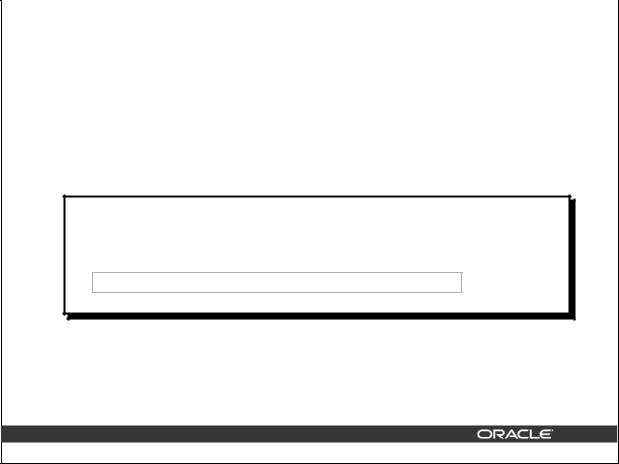
Using the WITH CHECK OPTION Clause
•You can ensure that DML operations performed on the view stay within the domain of the view by using the WITH CHECK OPTION clause.
CREATE OR REPLACE VIEW empvu20
AS SELECT |
* |
FROM |
employees |
WHERE |
department_id = 20 |
WITH CHECK OPTION CONSTRAINT empvu20_ck ;
View created.
•Any attempt to change the department number for any row in the view fails because it violates the
WITH CHECK OPTION constraint.
11-17 |
Copyright © Oracle Corporation, 2001. All rights reserved. |
Using the WITH CHECK OPTION Clause
It is possible to perform referential integrity checks through views. You can also enforce constraints at the database level. The view can be used to protect data integrity, but the use is very limited.
The WITH CHECK OPTION clause specifies that INSERTs and UPDATEs performed through the view cannot create rows which the view cannot select, and therefore it allows integrity constraints and data validation checks to be enforced on data being inserted or updated.
If there is an attempt to perform DML operations on rows that the view has not selected, an error is displayed, with the constraint name if that has been specified.
UPDATE empvu20
SET |
department_id = 10 |
WHERE |
employee_id = 201; |
UPDATE empvu20 |
|
* |
|
ERROR at |
line 1: |
ORA-01402: view WITH CHECK OPTION where-clause violation
Note: No rows are updated because if the department number were to change to 10, the view would no longer be able to see that employee. Therefore, with the WITH CHECK OPTION clause, the view can see only employees in department 20 and does not allow the department number for those employees to be changed through the view.
Introduction to Oracle9i: SQL Basics 11-17

Denying DML Operations
•You can ensure that no DML operations occur by adding the WITH READ ONLY option to your view definition.
•Any attempt to perform a DML on any row in the view results in an Oracle server error.
11-18 |
Copyright © Oracle Corporation, 2001. All rights reserved. |
Denying DML Operations
You can ensure that no DML operations occur on your view by creating it with the WITH READ ONLY option. The example on the slide modifies the EMPVU10 view to prevent any DML operations on the view.
Introduction to Oracle9i: SQL Basics 11-18
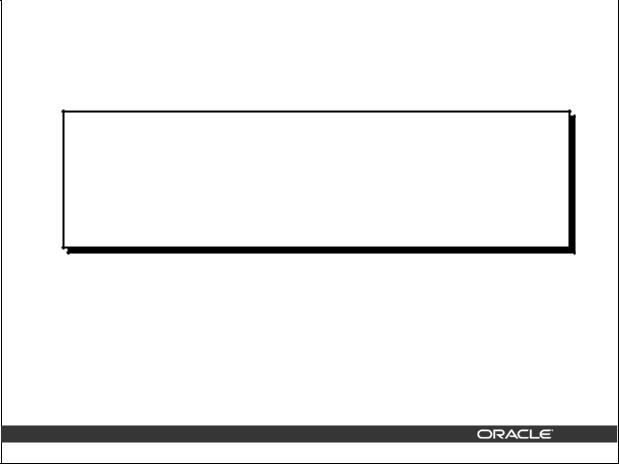
Denying DML Operations
CREATE OR REPLACE VIEW empvu10 (employee_number, employee_name, job_title)
AS SELECT |
employee_id, last_name, job_id |
FROM |
employees |
WHERE |
department_id = 10 |
WITH READ ONLY;
View created.
11-19 |
Copyright © Oracle Corporation, 2001. All rights reserved. |
Denying DML Operations
Any attempts to remove a row from a view with a read-only constraint results in an error.
DELETE FROM empvu10
WHERE employee_number = 200; DELETE FROM empvu10
*
ERROR at line 1:
ORA-01752: cannot delete from view without exactly one keypreserved table
Any attempt to insert a row or modify a row using the view with a read-only constraint results in Oracle server error:
01733: virtual column not allowed here.
Introduction to Oracle9i: SQL Basics 11-19
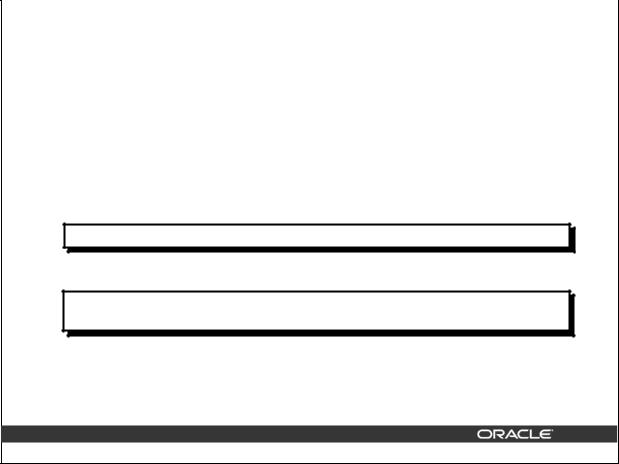
Removing a View
You can remove a view without losing data because a view is based on underlying tables in the database.
DROP VIEW view;
DROP VIEW empvu80;
View dropped.
11-20 |
Copyright © Oracle Corporation, 2001. All rights reserved. |
Removing a View
You use the DROP VIEW statement to remove a view. The statement removes the view definition from the database. Dropping views has no effect on the tables on which the view was based. Views or other applications based on deleted views become invalid. Only the creator or a user with the DROP ANY VIEW privilege can remove a view.
In the syntax:
view |
is the name of the view |
Introduction to Oracle9i: SQL Basics 11-20
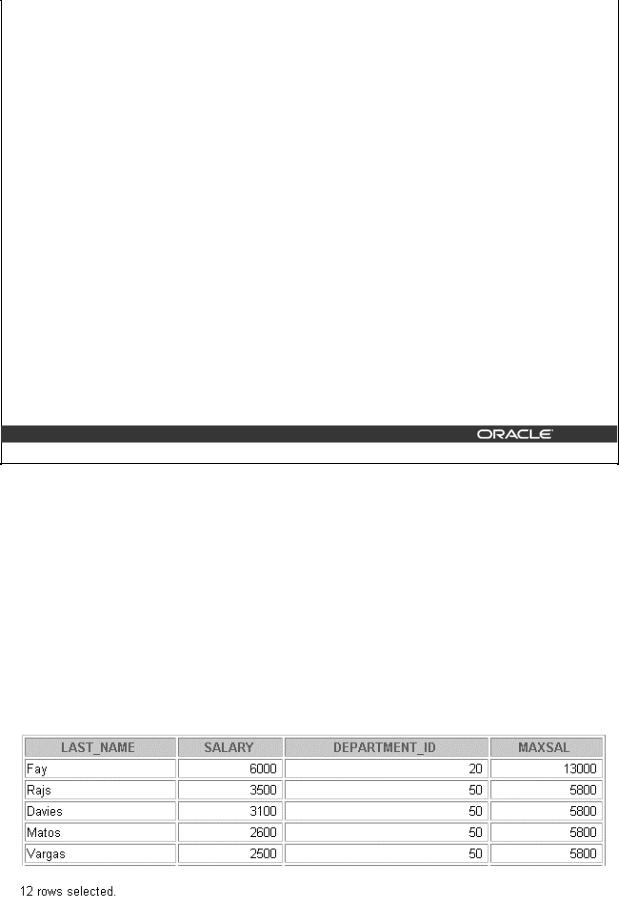
Inline Views
•An inline view is a subquery with an alias (or correlation name) that you can use within a SQL statement.
•A named subquery in the FROM clause of the main query is an example of an inline view.
•An inline view is not a schema object.
11-21 |
Copyright © Oracle Corporation, 2001. All rights reserved. |
Inline Views
An inline view is created by placing a subquery in the FROM clause and giving that subquery an alias. The subquery defines a data source that can be referenced in the main query. In the following example, the inline view b returns the details of all department numbers and the maximum salary for each department from the EMPLOYEES table. The WHERE a.department_id = b.department_id AND a.salary < b.maxsal clause of the main query displays employee names, salaries, department numbers, and maximum salaries for all the employees who earn less than the maximum salary in their department.
SELECT |
a.last_name, a.salary, |
a.department_id, b.maxsal |
FROM |
employees a, (SELECT |
department_id, max(salary) maxsal |
|
FROM |
employees |
|
GROUP BY |
department_id) b |
WHERE |
a.department_id = b.department_id |
|
AND |
a.salary < b.maxsal; |
|
…
Introduction to Oracle9i: SQL Basics 11-21

Top-N Analysis
•Top-N queries ask for the n largest or smallest values of a column. For example:
–What are the ten best selling products?
–What are the ten worst selling products?
•Both largest values and smallest values sets are considered Top-N queries.
11-22 |
Copyright © Oracle Corporation, 2001. All rights reserved. |
“Top-N” Analysis
Top-N queries are useful in scenarios where the need is to display only the n top-most or the n bottom-most records from a table based on a condition. This result set can be used for further analysis. For example, using Top-N analysis you can perform the following types of queries:
•The top three earners in the company
•The four most recent recruits in the company
•The top two sales representatives who have sold the maximum number of products
•The top three products that have had the maximum sales in the last six months
Introduction to Oracle9i: SQL Basics 11-22
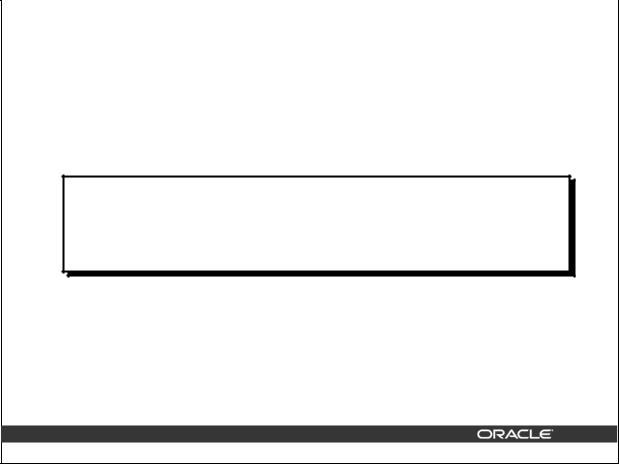
Performing Top-N Analysis
The high-level structure of a Top-N analysis query is:
SELECT [column_list], ROWNUM
FROM (SELECT [column_list]
FROM table
ORDER BY Top-N_column)
WHERE ROWNUM <= N;
11-23 |
Copyright © Oracle Corporation, 2001. All rights reserved. |
Performing “Top-N” Analysis
Top-N queries use a consistent nested query structure with the elements described below:
•A subquery or an inline view to generate the sorted list of data. The subquery or the inline view includes the ORDER BY clause to ensure that the ranking is in the desired order. For results retrieving the largest values, a DESC parameter is needed.
•An outer query to limit the number of rows in the final result set. The outer query includes the following components:
–The ROWNUM pseudocolumn, which assigns a sequential value starting with 1 to each of the rows returned from the subquery.
–A WHERE clause, which specifies the n rows to be returned. The outer WHERE clause must use a < or <= operator.
Introduction to Oracle9i: SQL Basics 11-23
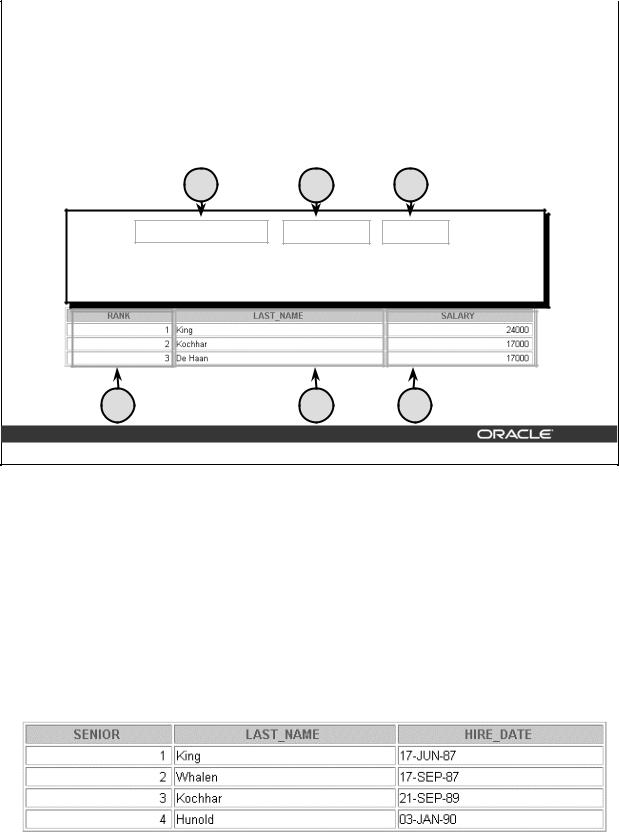
Example of Top-N Analysis
To display the top three earner names and salaries from the EMPLOYEES table:
1 |
2 |
3 |
SELECT ROWNUM as RANK, last_name, salary
FROM (SELECT last_name,salary FROM employees
ORDER BY salary DESC)
WHERE ROWNUM <= 3;
1 |
2 |
3 |
11-24 |
Copyright © Oracle Corporation, 2001. All rights reserved. |
|
Example of “Top-N” Analysis
The example on the slide illustrates how to display the names and salaries of the top three earners from the EMPLOYEES table. The subquery returns the details of all employee names and salaries from the EMPLOYEES table, sorted in the descending order of the salaries. The WHERE ROWNUM < 3 clause of the main query ensures that only the first three records from this result set are displayed.
Here is another example of Top-N analysis that uses an inline view. The example below uses the inline view E to display the four most senior employees in the company.
SELECT ROWNUM as SENIOR,E.last_name, E.hire_date
FROM (SELECT last_name,hire_date FROM employees
ORDER BY hire_date)E
WHERE rownum <= 4;
Introduction to Oracle9i: SQL Basics 11-24
